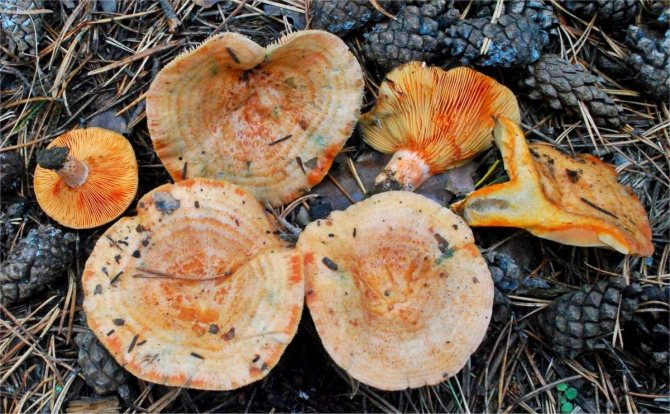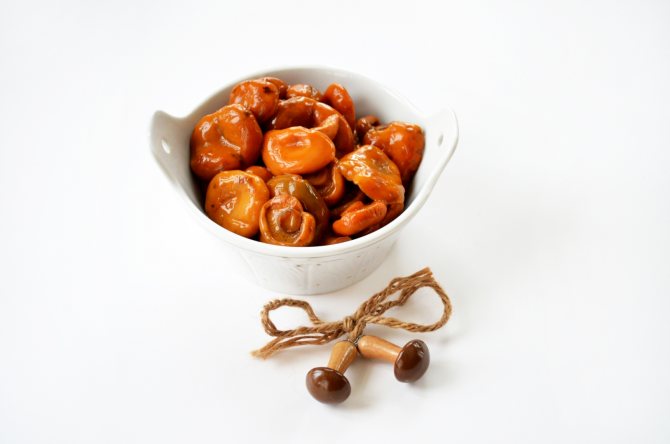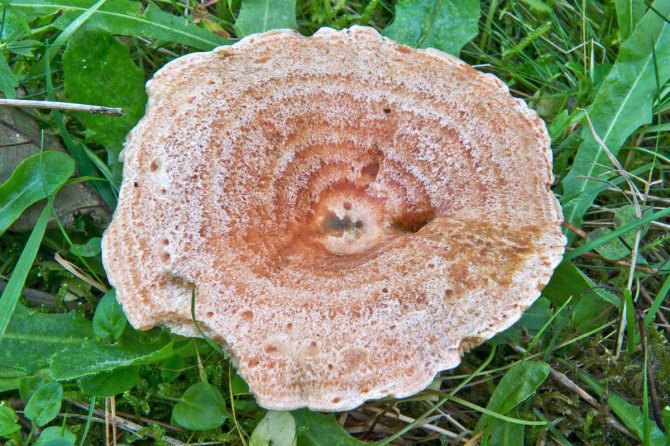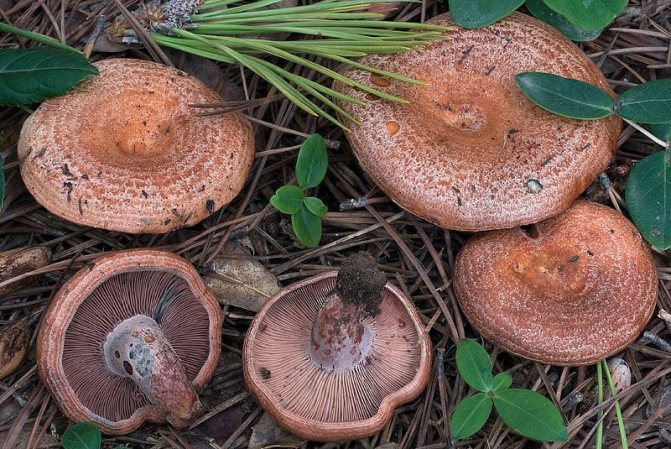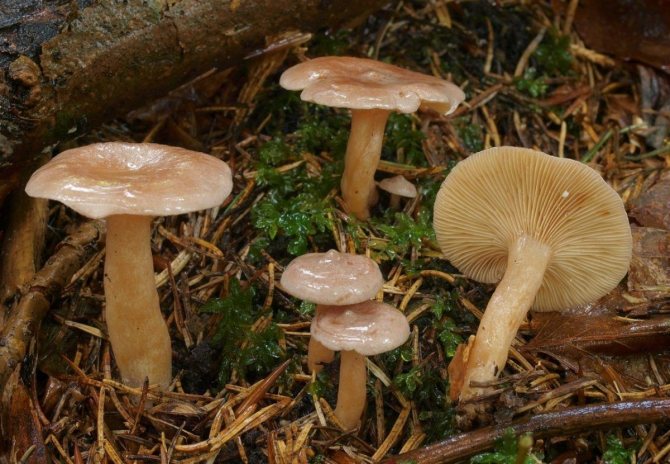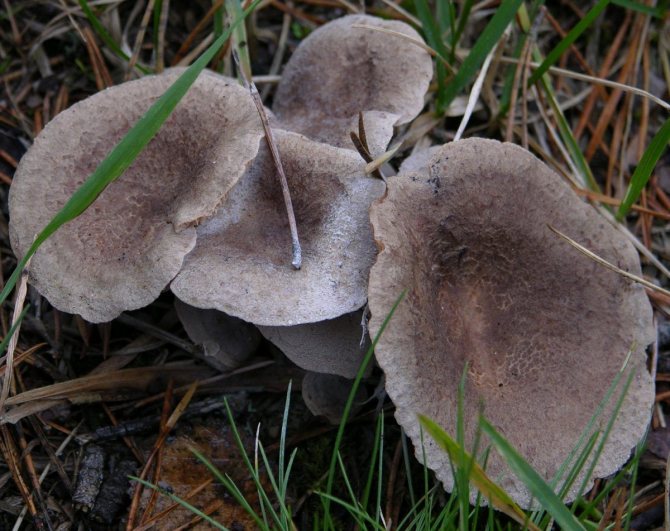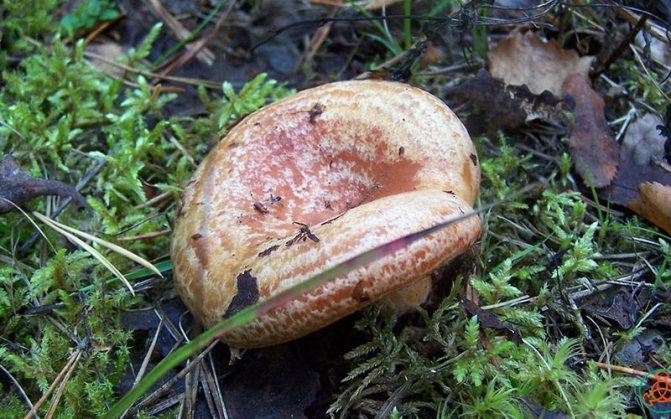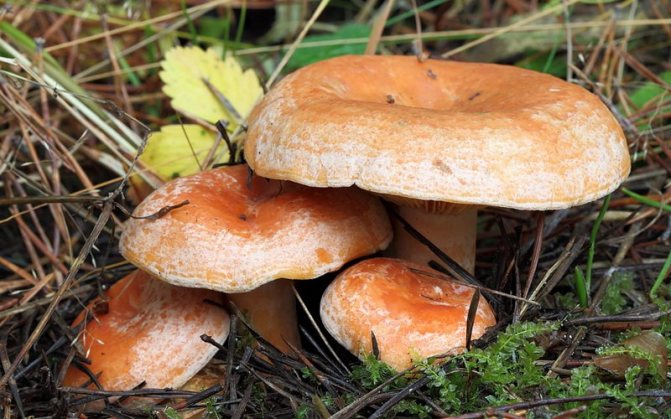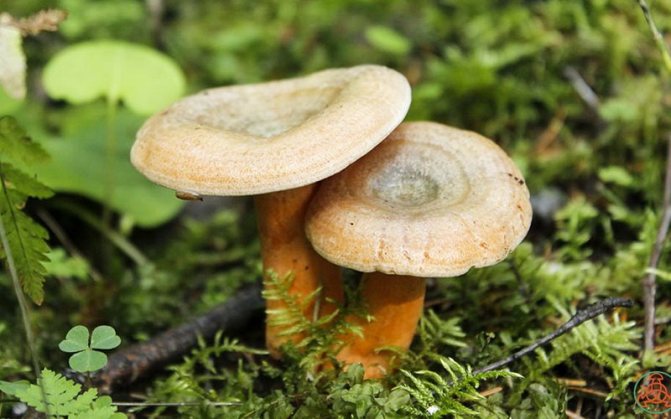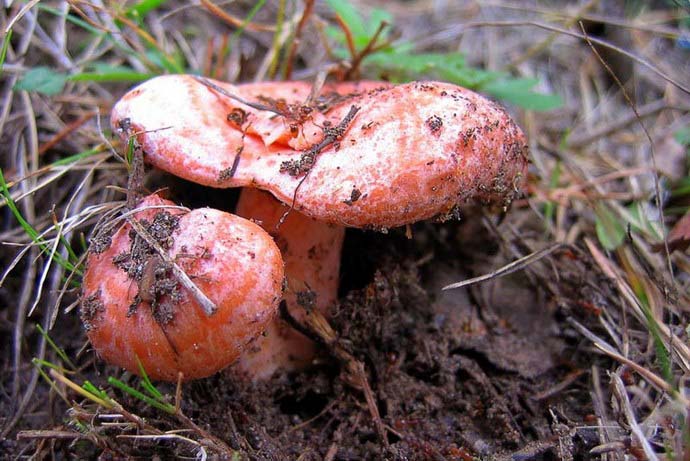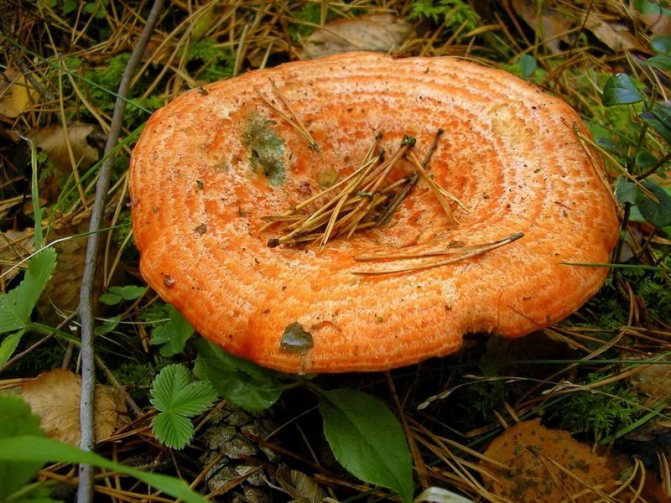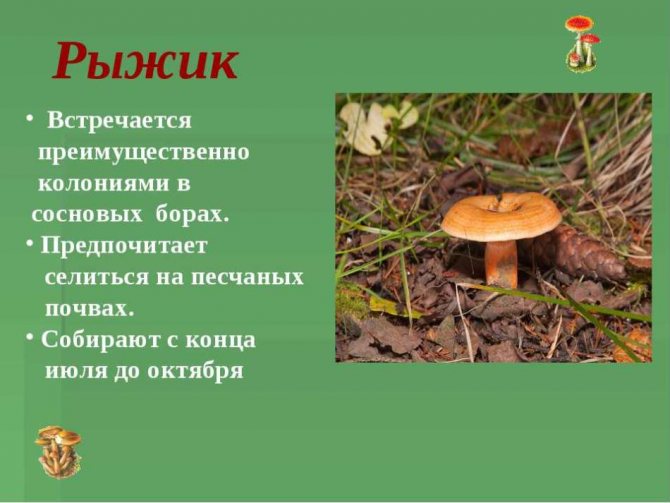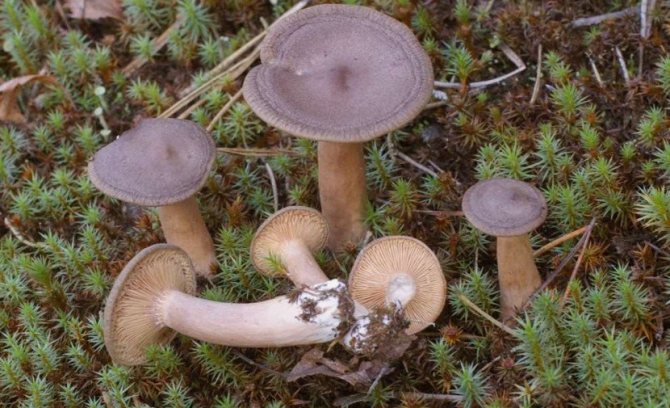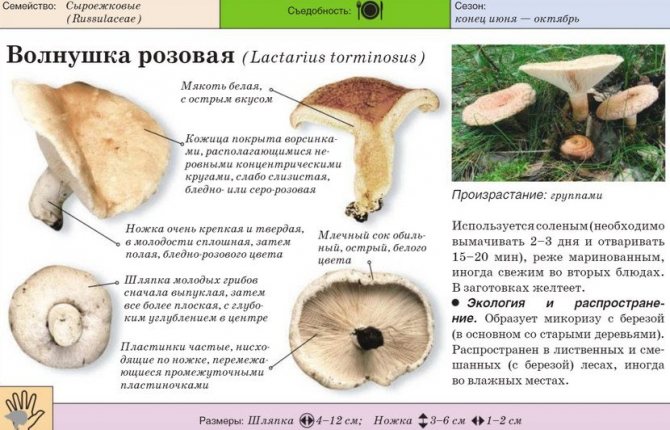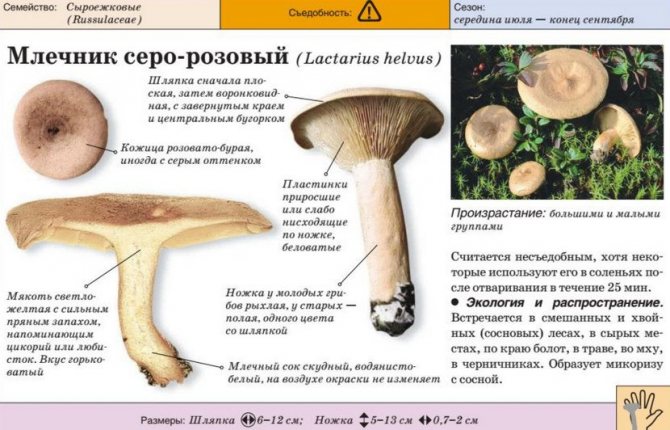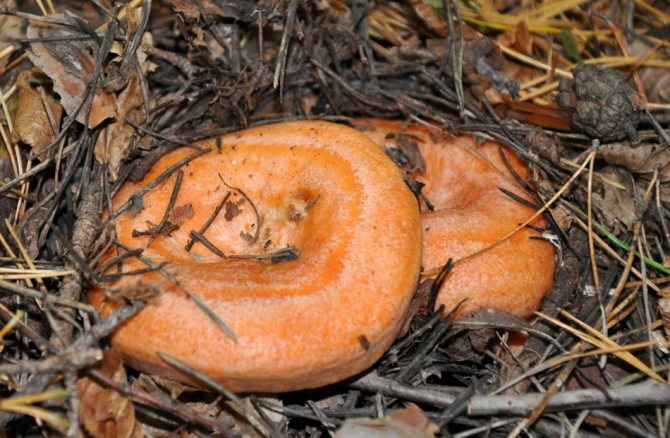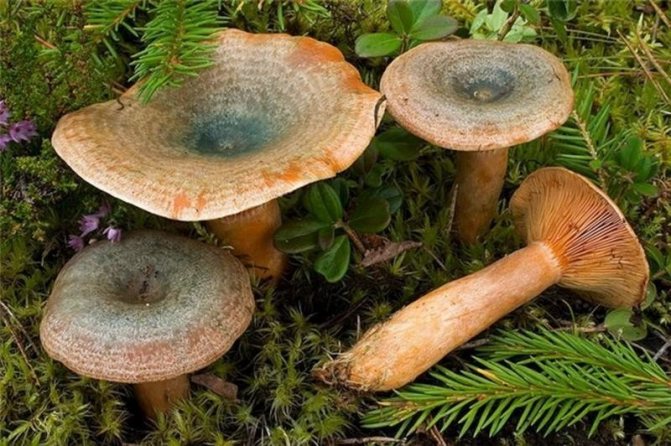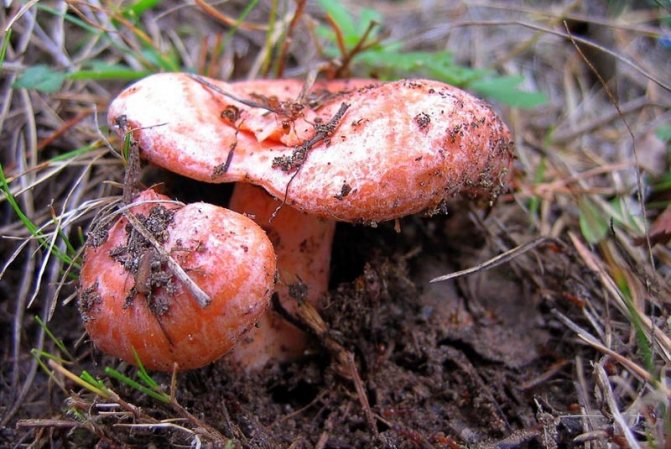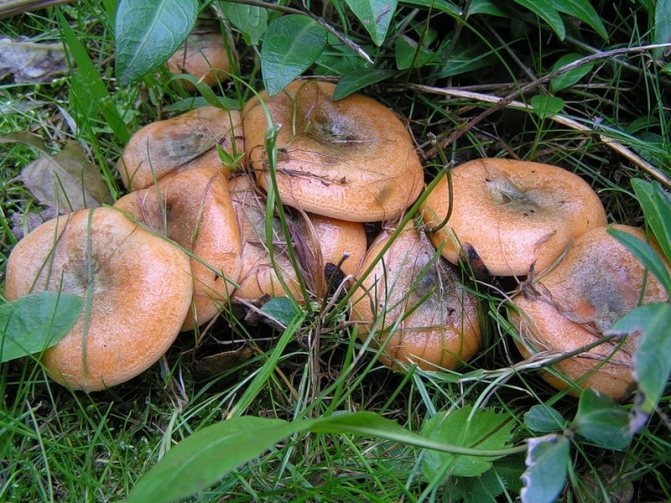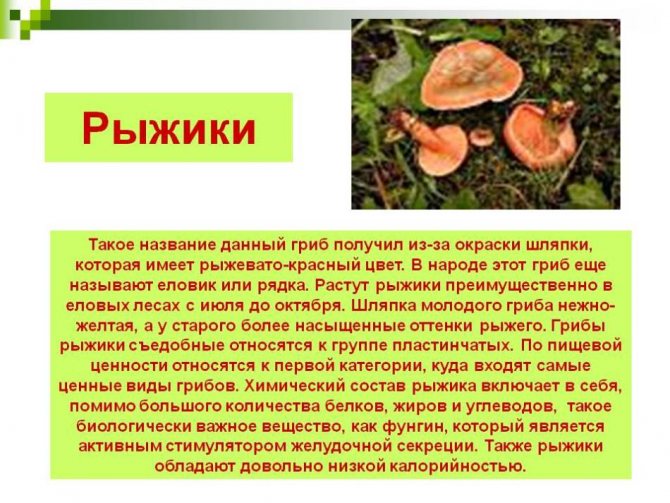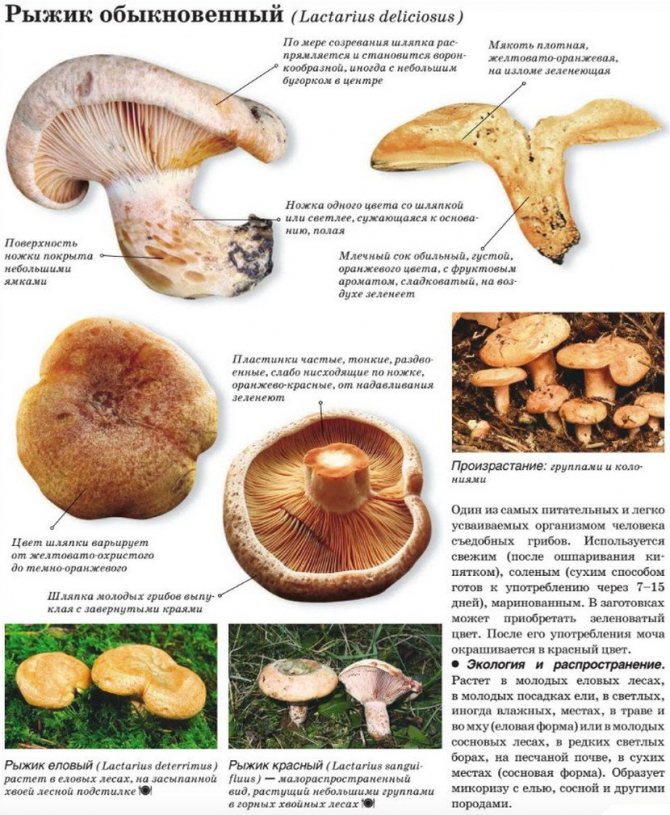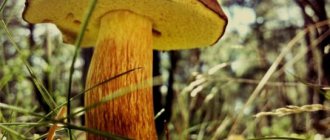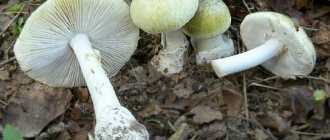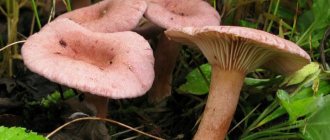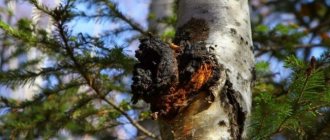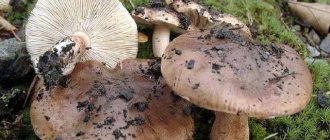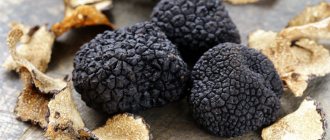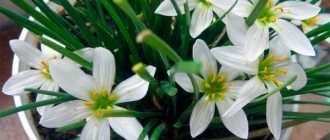»Mushrooms» Edible mushrooms »Ryzhiki - royal mushrooms with a coniferous flavor
0
137
Article rating
Ginger mushrooms (Lactarius sect. Deliciosi) got their name from the appearance of the fruiting body, which can be from bright red to more calm brown and reddish shades. This color appeared due to the high content of ꞵ-carotene. The same substance is found in large quantities in the milky juice of mushrooms.
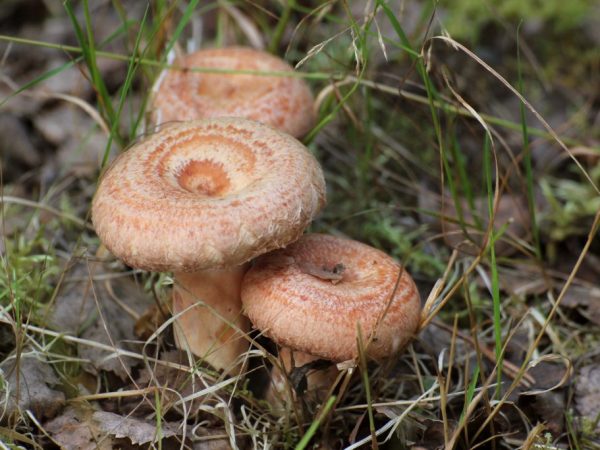
Ryzhiki - royal mushrooms with a coniferous flavor
general description
Ryzhiki (Lactarius sect. Deliciosi) - cap mushrooms. They belong to the russula family, genus Mlechnik.
They are appreciated all over the world, in some countries they are considered a delicacy. They are sometimes called Royal Mushrooms.
Harvesting is complicated by the presence of conditionally edible doubles and the “shy” nature of mushrooms: it is not easy to find them in the forest, since they hide under needles and dust.
How do they look:
- The cap is fleshy, convex at a young age, then sags in the form of a funnel, the edges are slightly curled down. Diameter up to 15 cm. Smooth to the touch, slight mucus formation possible.
- The color of the cap is from red-orange to light orange; as it grows, the degree of pigmentation decreases. The color is uneven, concentric zones have different intensities.
- Below the cap is dark brown, lamellar. The plates are narrow and frequent, adherent to the stem, descending towards it, orange in color, branched in some species. When pressed or other mechanical impact, they turn brown or turn green.
- The pulp is creamy, firm and thick. When broken, it quickly turns red, after which it oxidizes to green. At this place, a bright orange, non-poisonous, sweetish milky juice with a resinous smell is abundantly released. With prolonged contact with air, the juice turns green.
- The leg is hollow inside, cylindrical, grows up to 9-10 cm in height and 2.5-3 cm in width. More dense at its base. The color matches the hat, but the inside remains white. Turns green when squeezed.
How to distinguish mushrooms from waves, difference and similarity
It is worth noting that the color of the waves, in contrast to the saffron milk caps, is never red. Therefore, a mushroom of a reddish shade will most likely be just a mushroom. But it is better to visually inspect it to make sure of this and not pick mushrooms, similar to mushrooms... Do not forget that the cap of the saffron milk cap will be slightly sticky. How to tell them apart:
- Volushek, unlike other mushrooms, have a shaggy cap. In saffron milk caps, it is smooth.
- The cap of the waves inside is always pinkish, and in saffron milk caps it can be from light yellow to bright orange. Older specimens may even have a greenish blue.
- Ryzhiks prefer coniferous forests. In deciduous, you can pick up waves.
- Volnushki are almost always half the size of saffron milk caps.


Composition and useful properties
Useful properties of saffron milk caps are due to the presence of:
- ꞵ-carotene, which is converted into vitamin A in the human body;
- ascorbic acid;
- fluorine;
- B vitamins;
- iron salts;
- mineral salts of calcium, sodium, potassium.
As a percentage, the chemical composition can be expressed as follows:
- water about 90%;
- easily assimilated amino acids in large quantities (included in the composition of proteins) - 4%;
- fiber 2%;
- carbohydrates 1.5%;
- fats 1%;
- minerals 1.5%.
Regular use of these mushrooms improves the condition of the skin, stimulates the growth of hair and nails, and has a general strengthening effect on the body.
An interesting fact: the composition contains a powerful antibiotic - lactarioviolin. It inhibits the growth of many bacteria and is used medicinally to treat many diseases, including tuberculosis.
Fresh mushroom soup
You will need:
- Ryzhiki - 250 gr.
- Pearl barley - 2 tbsp. spoons.
- Onions - 1 pc.
- Butter - 1 tbsp. the spoon.
- Dill, sour cream, pepper and salt - take the amount at your discretion.
Preparation:
- Rinse and soak the barley for at least an hour. Then fill with water and cook until almost completely cooked.
- Cut the mushrooms prepared for cooking and fry together with the onions. Add to soup.
- It remains to salt, pepper and cook until tender. Shortly before the end, place the chopped dill, leaving a little to decorate the finished mushroom soup. Serve with sour cream.
Contraindications


Gingerbread should not be eaten by people with gastrointestinal problems
Gingerbreads are not recommended for use when:
- removed gallbladder;
- cholecystitis;
- pancreatitis;
- gastritis of any type;
- individual allergic reaction.
The unrestrained eating of saffron milk caps can make it difficult to defecate, muscle weakness also appears, and a general decrease in working capacity occurs.
Salted, fried and pickled mushrooms become extremely high in calories, so they are excluded from the diet for those who are losing weight.
Harm and benefits of saffron milk caps for the body
These yellow-orange mushrooms are a real natural antibiotic. The medicinal substances contained in them cope with pathogens and even with Koch's bacillus. Camelina contains so many different vitamins and minerals that they can easily overtake any vegetables and fruits in usefulness. The benefits of these mushrooms for the body are due to the fact that they:
- They have an anti-inflammatory effect.
- Cope with various fungal diseases.
- Remove toxins from the body.
- Eliminate bloating.
- They have a beneficial effect on vision.
- Improves bowel function.
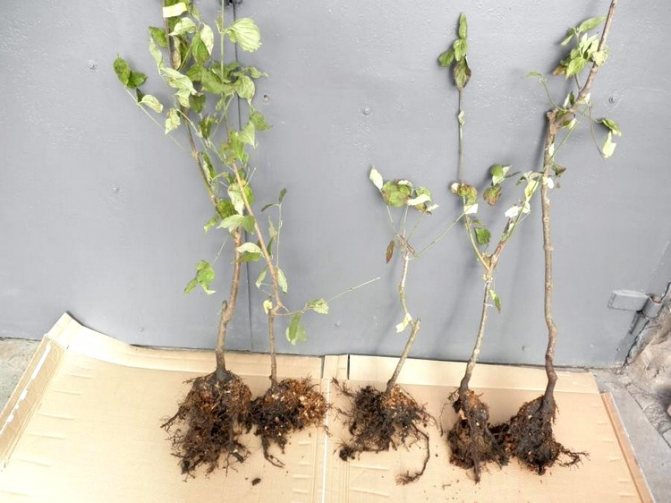

But despite all their useful qualities, these mushrooms also carry some harm. They are contraindicated to use for problems such as:
- Low stomach acidity.
- If the gallbladder is removed.
- For constipation problems.
- If you have liver disease.
In addition, with a significant overeating of such mushrooms, urine may turn reddish, fatigue, and constipation. Therefore, everything needs to know when to stop.
When and where to collect
These mushrooms are most common in the north of Russia. They prefer conifers and can often be found in the following places:
- edges and meadows;
- former tree felling;
- young spruce forests.
They grow in small groups. It is worth looking for them under fallen leaves and needles after mushroom rains. In drought, it is almost impossible to find a mushroom.
Quiet hunting is carried out from July to the end of September, with the peak of growth in August. In the fall season, they can be overgrown and wormy; collecting such specimens is not recommended.
If you have found a place of active growth of saffron milk caps, then you can return to it after each rain: the mycelium will give a new crop.
The best time to harvest these mushrooms is in the early morning, while the dew persists. Young mushrooms that have grown overnight are not yet wormy, which can be expected by noon. One of the sad features of saffron milk caps is considered their instability against all sorts of pests.
():
The mushroom parasite, brick-red Pekiella, often settles on saffron milk caps. Its mycelium permeates the entire fruiting body of the host and causes a reduction of the plates, forming stroma on them, covering almost the entire underside of the caps. As a result, the plates acquire the appearance of low ribs, do not develop fully (they cannot participate in the formation of spores), and sometimes they are generally invisible.Mycologists call such parasite-affected mushrooms "stone" or "deaf". Collecting them is not recommended.
However, the harm that the larvae of flies and mushroom mosquitoes inflict on mushrooms is much greater than from the development of pequiella on the mushroom.
Camelina vegetable stew
The recipe contains potatoes, but you can replace it with cabbage, or even put both. Take:
- Potatoes.
- Ryzhiki.
- Flour.
- Sour cream.
- Salt, dill, parsley and pepper.
Cooking:
- Cut the peeled potatoes into cubes and boil. The potatoes should be almost ready. Do not pour too much water, it should only cover the potatoes.
- Add chopped mushrooms to the potatoes.
- Add a little flour to the sour cream (a small 230 g jar will need 10 grams of flour) and stir so that there are no lumps. Pour sour cream into a saucepan with camelina and potatoes, salt, pepper and stir.
- Put the contents of the pan in a mold and send it to the oven to simmer at 180 degrees. When the vegetable stew is baked and golden brown, garnish with parsley and dill.
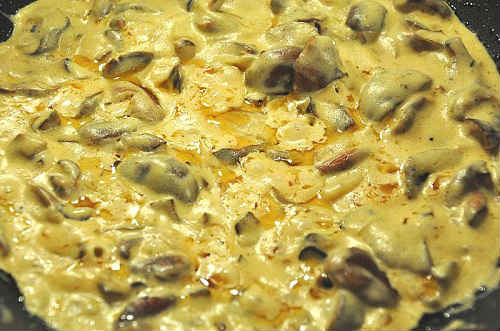

Edible varieties
Ginger real
The cap grows up to 18 cm wide; with age, it bends from a convex one in the form of a funnel with a tubercle in the center.
Smooth when touched in dry weather, with high humidity it becomes sticky, shiny. The color is intense orange, with brownish spots and diverging circles.
The plates are thin, bifurcated, orange-red. When pressed, they turn green.
The color of the leg is similar to that of the cap. It grows up to 7 cm in height and 2 cm in width, hollow inside.
Real mushroom flesh is dense, yellow-orange, when cut, it changes to green, the milky juice of the mushroom is oxidized, it is thick, smells of freshness and fruit, abundant, orange.
Pine mushroom
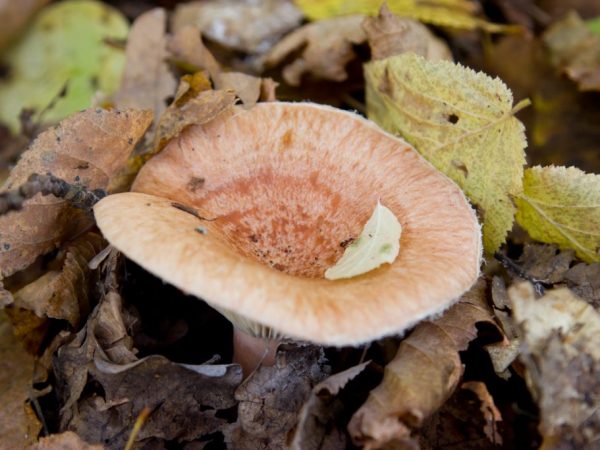

Mushroom slice turns green over time
The fruit body is reddish-brown, strong. It often turns green after harvest.
This species is stocky and grows in small groups. The cap is creamy or orange-yellow, with brownish spots, up to 16-18 cm wide. When the mushroom matures, the edges of the cap rise, giving it the shape of a curved funnel.
At high humidity, the cap is sticky, otherwise it is slightly damp. The leg is hollow, it grows up to 8-9 cm.
The pulp is dense, turns green even from light touches. The milky juice is thick, has a pungent taste, a weak resin aroma, and quickly oxidizes to green.
Pine camelina is more common than others; the mushroom grows in pine forests and mixed forests.
Mushroom pickers often call it "hog" or "boletus", thus emphasizing the features of the external structure that make it look like a porcini mushroom.
Spruce ginger
It grows exclusively near spruce trees, since the mycorrhiza forms mycorrhiza with the roots.
The color of the cap is orange; with age, it darkens and turns green, starting from the center. There is pigmentation in the form of rings and spots. Under the influence of sunlight, it becomes more faded, a white bloom appears. The pulp is characterized by a pleasant taste and fruity aroma.
The thin orange leg grows up to 7 cm and is extremely fragile. On its surface, dents are often found in a darker tone than the main color. When harvested, fruiting bodies are difficult to keep intact as they crumple from any touch. Milky juice is very abundant, reddish, oxidized to green.
When salted, spruce mushrooms turn green-brown.
Red ginger
The cap grows up to 15 cm wide. It is flat in shape, sometimes slightly convex, with a curved edge.
The plates sometimes fall apart, deeply (far enough) descend along the leg. The color of the hymenophore can vary from ocher to pinkish and even wine red.
The surface is smooth, not sticky, pleasant to the touch, orange. The flesh of the saffron milk cap is dense, fragile, breaks in the hands, the color is white with brown or dark red spots.
The stem is cylindrical, full in young mushrooms, but becomes hollow as it matures. It grows up to 6 cm, there are pits on it and a bloom reminiscent of flour.
Milky juice is red, abundant, thick.
This type of saffron milk cap is very common in forests. The time of fruiting and reproduction is from mid-July to the end of September.
Milky red mushroom
Its fleshy cap grows to a maximum of 7-9 cm in width, but most often there are specimens with a hat diameter of 4-5 cm. It is flat, with curved edges and a slightly sunken cent.
The color of the cap is light orange, pinkish to the edges. As they grow older, the color scheme becomes more green. The plates under it are orange with a pink tint in young people, turn red with age.
The leg is hollow inside, up to 7 cm high, very fragile, like the pulp.
Mushroom juice is orange, oxidizes in two stages: first it turns red, then it turns green. This mushroom grows exclusively near pines.
Japanese ginger
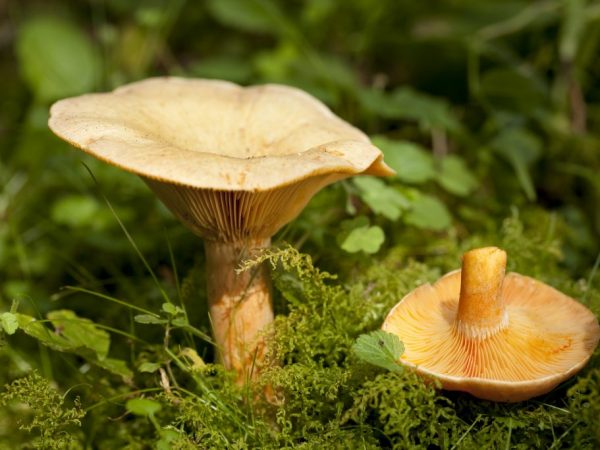

Caps in adult mushrooms take on the shape of a funnel.
The cap in youth is flat with a depression in the center; in older specimens, the edges rise, giving the shape of a funnel. It grows up to 8 cm, has a color from ocher to pink-cream, with darker spots.
The leg is large, up to 7.5-8 cm in height and 2 cm in width, hollow and fragile. Its color is considered a characteristic feature: it is intense, red-orange, with a white line on top.
This type of saffron milk cap has a very characteristic feature that distinguishes it: the flesh does not turn green on the break.
Japanese camelina has a red, non-oxidizing milky juice. Distribution area - Japan, southern regions of Primorsky Krai. You can find this mushroom under the fir, the time of collection is September-October.
Pickled mushrooms - a recipe for the winter
How to pickle other mushrooms, you can find out, I wrote. The wonderful recipe proposed today is perfect for pickling fresh whites, boletus mushrooms, honey agarics.
- Ryzhiki - 3 kg. Try to keep it small.
- Salt - 4 tablespoons.
- Vinegar, essence - 1 dessert spoon.
- Peppercorns - 8 pcs.
- Water - 6 glasses.
Marinate:
- To cook pickled mushrooms, sort them, wash and put them in a saucepan (for pickling, it is better to take an enamel dish). The water should completely cover the mushrooms, but too much is also not needed.
- Boil water with mushrooms and cook for exactly one minute. Remove the foam, discard the mushrooms in a colander and rinse well.
- Boil water and add salt. Put the mushrooms in the boiling brine and cook for 6-7 minutes. At the end, add pepper and vinegar. Turn off the heat immediately.
- Arrange the mushrooms in jars and pour the marinade all the way to the top. Sterilize and roll up. It is enough to sterilize half liter jars for 12 minutes, liter jars - 15.
Probably, the mushrooms inherited something from the gnomes from the fairy tale. Bright, with red hats, they can hide in the grass, and standing side by side, sometimes it is difficult to notice them. But if you find it, then a whole family at once!
And if you know how to cook mushrooms, having invested not only knowledge, but also your soul, then the whole winter you will listen to words of gratitude from loved ones.
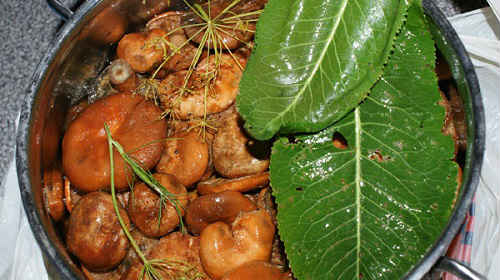

False doubles
The main danger of eating raw mushrooms is considered to be the presence of twin mushrooms.
False mushrooms require mandatory heat treatment and salting, often for a long time. Without this, they can lead to poisoning, loss of mind, or death.
You can distinguish them from edibles by the milky juice: it is light and does not oxidize upon contact with air.
Harvesting is not recommended unless you are sure you can tell the difference between a real camelina and its counterpart.
Pink wave
It belongs to the conditionally edible category.
Salting less than 45-48 days and poor short-term heat treatment leads to disruption of the gastrointestinal tract.
Volnushka is found in the north of Russia, prefers deciduous forests. It grows mainly at birch roots.The hat is light pink, with ragged edges, which are compared to fringe or lace. The pulp is white, with a pungent taste, it emits a non-oxidizing white milky juice.
Milk papillary
It belongs to the conditionally edible category.
Occurs in coniferous forests on light sandy loam. The hat is dry, gray. Milky sap is whitish, does not oxidize on contact with air. In young mushrooms, it has a sweetish taste, in adult specimens, it is sharp and bitter, but in overripe, it is practically absent.
The pulp is white, easily breaks, has a light coconut aroma, darkens at the break. This mushroom is eaten only after prolonged soaking and mandatory salting for at least 47 days.
Fragrant miller
Conditionally edible.
Grows in small groups, mainly under birches. The pulp is creamy, brittle, with a strong aroma. The smell of a mushroom is compared to fresh hay or coconut.
The length of the stem can be equal to the diameter of the cap or slightly exceed it.
It is recommended to cook for 15-20 minutes before salting. Milky sap is white, does not oxidize.
Fried mushrooms - simple recipes
Recipe number 1. The simplest but most delicious recipe for fried mushrooms, you will love it without a doubt.
Take:
- Ryzhiki - 400 gr.
- Onions - 1 pc.
- Lard - 80 gr.
- Salt.
Cooking:
- Cut the bacon into cubes, put it in a frying pan, add the onion, chopped mushrooms and fry, stirring often.
Recipe number 2. You will see the next option by watching the video:
Recipe number 3. Fried mushrooms in sour cream. Quite a simple recipe, unpretentious. We take:
- Ryzhiki.
- Sour cream.
- Bulb.
- Croutons, white.
- Salt, dill, black pepper.
Step by step cooking:
- Peel the mushrooms, boil in salted water for about 10 minutes. Drain and send the mushrooms to the pan.
- Fry the onions separately and add to the mushrooms. Season with pepper, salt and dill. Fry until golden brown.
- Pour in sour cream, put crackers (put not too much, in moderation). Let it boil and after a couple of minutes turn off the heat.
How to cook properly


Mushrooms need to be peeled quickly
Any method of cooking mushrooms involves pre-cleaning them.
- It is necessary to sort out the mushrooms. They develop very quickly insect larvae (worms), so they try to cook them as soon as possible. Some mushroom pickers brine prey right in the forest, immediately after harvesting.
- Fruit bodies are washed. It is better to do this in a bowl or bowl of water, since the strong pressure of the jet can break fragile caps and legs.
- Then the crop is thrown into a colander to glass the water. If this is not done, the mushrooms will give too much liquid during frying. Do not dry them before cooking.
An interesting fact: mushrooms are very difficult to clean from forest debris without water, since they are very brittle and cannot withstand manipulation with a brush and rags.
Freezing
In frozen mushrooms, almost all the beneficial properties for the human body are preserved. This must be done as soon as possible after collection.
To do this, the peeled mushrooms are sorted out, quickly washed, allowed to drain off the water and only after that they are removed in bags or containers and placed in the freezer. Freezing wet mushrooms will allow the ice to grab better and keep its shape.
Cooking
Edible species can be cooked for about 15-20 minutes; it makes no sense to cook them longer. At the same time, they give a thick rich broth, which can become a good basis for a mushroom picker - this is the name of the soup from russula.
For the simplest recipe you will need:
- mushrooms - 0.5 kg;
- potatoes - 0.6 kg;
- carrots - 0.2 kg;
- onions - 0.2 kg;
- water - 3.5 l;
- bay leaf, salt, pepper - to taste.
Peeled and chopped mushrooms are dipped in boiling water, salted and pepper, boiled. Peeled carrots are grated, prepared onions and potatoes are cut as convenient.
By the time they are ready, add potatoes to the pan, cook for another 10-12 minutes. Onions and carrots are placed last.
Drying
Drying mushrooms is not as difficult as it might seem. For this method of harvesting saffron milk caps for the winter, you must:
- Purchase a special dryer. Electric ones do not cost much, the average price in online stores is about 2000 r.
- Minimize contact of fungi with water. This means that you will have to try to clean them well from forest debris. Experienced culinary experts advise using rags and toothpicks to check the plates under the hat and remove pinpoint stains.
Large specimens are cut, and small ones are left intact. Before placing the mushrooms in the dryer and after cleaning, they are placed on a newspaper or towel to dry for a while.
There is another option - to dry the mushrooms on a string. To do this, they are strung on a thread with a needle. It is pulled in a warm, ventilated place, often in the kitchen. It may take a week for it to dry completely.
Frying


Ryzhiki are versatile in cooking
Frying mushrooms is easy. They are laid out in a frying pan with heated vegetable oil.
The evolved liquid is evaporated on medium heat. After its evaporation, add onion, cut into small pieces.
Season at the moment when it starts to “shoot”. Culinary experts advise not to use anything other than salt, as royal mushrooms can lose their unique coniferous taste.
After adding the seasonings, the mushrooms are fried over low heat for another 5-7 minutes. Serve hot or warm.
Salting
One of the simplest and most successful solutions.
These mushrooms are able to show all facets of their taste in brine, if you do not add aromatic spices.
The difference between cold and hot salting is storage time. When using boiling water, mushrooms will stand longer than without it.
Eating raw
Raw mushrooms will bring much more benefits than cooked ones. They are pleasant to eat, since they do not taste bitter at all and have a delicate, exquisite coniferous aroma.
Mushrooms are added to salads and served as an appetizer for side dishes.
It is necessary to accurately determine the species before use, otherwise false doubles can cause considerable harm.
It is worth remembering that raw mushrooms are tasty prey for various pests, so they cannot be stored in the refrigerator for a long time. Best eaten within 2-3 hours after picking.
():
- Ryzhiks belong to category I Their advantage is that they do not need pre-soaking. You just need to wipe well and at the same time carefully (so as not to damage) with a damp cloth, remove adhering leaves and other forest debris from the surface, and also cut off the lower part of the leg.
- Salted mushrooms can be eaten for 14 days.
- When digested in the human body, substances are released from the spruce camelina that color the urine red. Therefore, you do not need to panic and go to the doctor in order to conduct an analysis for the presence of blood in the urine.
Signs of a good saffron milk cap:
- He is small, young.
- It was collected in the middle of the forest, not near a road or highway.
- The mushroom body is not wormy, pure.
- There are no suspicious spots, blotches, dents on the surface.
Camelina mushrooms - cooking recipes
It always seemed to me that he was from a fairy tale. And it turned out that I was not mistaken. According to an old legend, mushrooms appeared on the earth thanks to the gnome. More precisely, his hat.
Usually gnomes don't like meeting people. They hide because they are constantly asking for something. But there was a little dwarf among them, who communicated with people willingly. He wore an orange hat and helped everyone, especially poor people. To whom he will give a handful of gold coins, whom he will guide to the treasure. But people are ungrateful creatures, they often hit the gnome with greed. And in the end - in the end they were so tired that he got tired of empathizing with them and ... disappeared forever. He left only a parting gift for people - a hat on the grass.
The bright orange hat has turned into a beautiful mushroom. It is quite possible that the gnome made a gift to people with a hint: if you want to have money, make money! Collect mushrooms and sell.
In tsarist Russia they did just that. Ryzhikov was growing in the woods apparently and invisibly. And Russia was famous for its salted mushrooms all over the world. From pre-revolutionary Russia, from the Urals, they sent mushrooms in bottles to France. And they say that they cost more than the famous French champagne. We will not give the mushrooms to the French, we will cook ourselves: we will salt, marinate for the winter, boil, dry, stew. Let's prepare both soup and main courses.
And immediately advice:
- Mushrooms do not need to be soaked before cooking.
- Remove debris, wipe with a damp cloth, pour over with boiling water.


Preparation and processing of mushrooms
In order to preserve mushrooms with high quality at home, it is important to choose the right source material. The best in appearance and taste are pickles from young mushrooms, which were collected in a pine forest. Their delicate taste, dense juicy texture will qualitatively enhance any side dishes.
First, you need to carefully sort out the collected mass, removing wormy, spoiled units. The remaining material must be freed from various contaminants, needles. It is advisable to cut large specimens into several parts for better impregnation of the mushroom pulp.
Features of storage of workpieces
The shelf life of any workpieces depends on the conditions. Fried or baked food can be stored in the refrigerator for no more than 1 week. Bacteria begin to develop at a temperature of + 5 ° C. Therefore, food can be stored on the table in the kitchen for no more than 2 hours. Use a refrigerator to extend the shelf life.
Did you know? Nobody knows how many types of mushrooms exist in nature. There are about 10,000 described species, but scientists believe that there are many more undescribed.
If a lot of mushrooms are collected, then some of them are frozen for further consumption. Cooking both fresh and frozen mushrooms is easy. But when cooking, pay attention to the processing speed of the ingredients. It depends on how the finished dish will turn out in taste and consistency.

